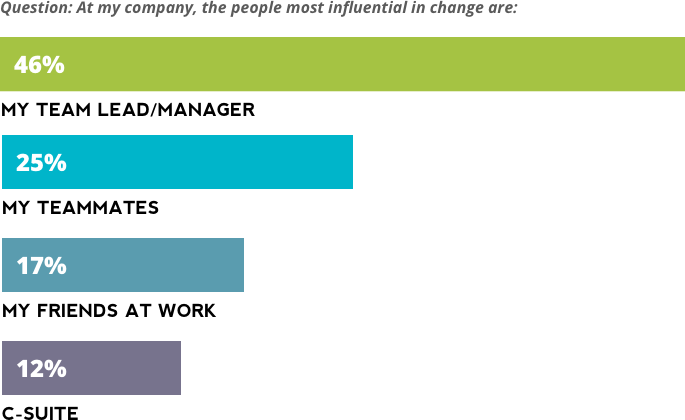Report
Reinventing change management

THE CHANGE AGENTS HIDING IN PLAIN SIGHT: WORKFORCE TEAMS
A new Eagle Hill Consulting survey shows that according to employees, optimizing change is a weak link in workplace teams. Only 21 percent strongly agree that their teams respond enthusiastically to change.

With disruption exploding, technology advancing and business models evolving, an organization’s capacity to change is a competitive advantage. While S&P 500 companies used to stay on the Index for decades, the average tenure is expected to plummet to just 12 years by 2027, according to Innosight.
In this environment, leaders know they need an adaptive organization to move the business forward, and they are investing in traditional top-down and bottom-up change management initiatives to cultivate this capability. But these approaches do not always work. Seventy percent of transformation efforts fail, according to Harvard Business Review.
One reason for these failures is that linear, role-based approaches to change that focus solely on individual adoption do not align with how people work today—in teams. In fact, Harvard Business Review reports that employees spend 50 percent more of their time on collaborative work than they did 20 years ago. Companies must address this disconnect between business-as-usual change models and new ways of working to build their organization’s all-important capacity for change.
Teams in Sports, Teams at Work: Ability to Change a Critical Success Factor
With teams so critical to how companies face down change—and ultimately, to how they compete in changing environments—we wanted to understand how well workplace teams are functioning today.
Our survey of US part-time and full-time employees measures three critical elements of high-functioning teams: cohesion, performance, and continuous growth and change. As Figure 1 shows, each element, which is made up of key factors, is essential on its own. Together, they set the foundation for a team’s success.
Figure 1: High-functioning teams have cohesion, performance and continuous growth and change.



Purpose: Team has a common purpose
Trust: Teammates trust each other
Shared success: Teammates commit to team success
Motivation: All teammates are highly motivated
Clarity: Team leader sets clear expectations
Insight: Team leader addresses performance issues
Improvement: Team leader helps each teammate improve
Rewards: Team leader recognizes outstanding performance
Outcomes: Team consistency exceeds goals
Learning: Team constantly learns and gets better
Adaptivity: Team enthusiastically responds to change
Source: The Eagle Hill Consulting Workplace Teams Survey 2019
Winning sports teams have these things in abundance. However, the survey results reveal this is not true for teams in the workplace—and that there is significant room for improvement:

Cohesion: Stacking hands
Cohesion is team unity, an ethos grounded in the spirit of “all for one, and one for all.” According to Carron, Brawley, and Widmeyer (1998), team cohesion is “a dynamic process” and multidimensional. This includes alignment around goals, roles and operating agreements. While a clearly defined purpose is key, only 28 percent of employees strongly agree their team has one.
The other dimension of cohesion is the intangibles, the interpersonal and social factors that bind the team together. This area needs improvement. Just 29 percent of employees strongly agree that they trust their teammates. Only 27 percent strongly agree their teammates are committed to the team’s success. And a mere 24 percent strongly agree that their teammates are highly committed to the team’s work.
Companies cannot dismiss the importance of team cohesion. Cohesion affects team performance and ability to change. Sports fans know this. They have watched dream teams of elite athletes fall and cohesive teams with less talented athletes triumph. Research published in Sport Sciences for Health confirms a correlation between team cohesion and team performance.

Performance: Shooting for the goal
Team performance is not about a collection of individual performances. It is a coordinated collection of performances where the whole is greater than the sum of the parts. It is also about the strength of the support structures that individual teammates and entire teams have behind them.
On sports teams, coaches are responsible for orchestrating these supports to get optimal performance from teams. Team leads are the coaches of workplace teams. Only about three in ten employees strongly agree that their team lead sets clear expectations (30 percent), addresses performance issues as they arise (25 percent), and recognizes outstanding performance (28 percent). Only 21 percent of employees strongly agree that their team lead helps them get better. Equally troubling, team leads are not contributing to “wins” at work. Only 21 percent of employees strongly agree that their team consistently meets its goals.

Change: Being a champion
There is no definitive answer for why workplace teams are not effectively delivering change. However, the survey suggests a trend around a lack of change-readiness and continuous improvement. Of all the factors surveyed, employees are least likely to agree that their teams enthusiastically respond to change, and only 21 percent strongly agree. Just 24 percent strongly agree that their team constantly learns and gets better. Ironically, teams’ weakest link is essentially what companies need the most to compete today.
When asked who in the company is most influential in change, employees overwhelmingly point to their team lead over teammates, work friends and the C-suite, as shown in Figure 2. Yet of all the factors that team leads foster for their teams, embracing change and continuous growth rank last, which suggests that the recognized change champion is not prioritizing change.
Figure 2: Employees view team leads as the most important influencers of change at the workplace.

Source: The Eagle Hill Consulting Workplace Teams Survey 2019
Playbook for Team-Based Change
To win in dynamic business environments, companies need a new playbook to improve workplace teams and how they embrace change. Download the full report to see the five building blocks of change-ready teams.


